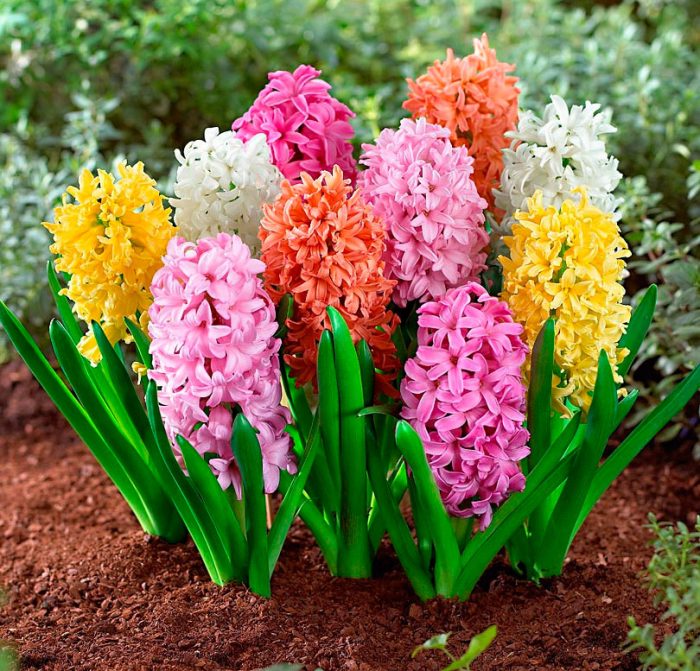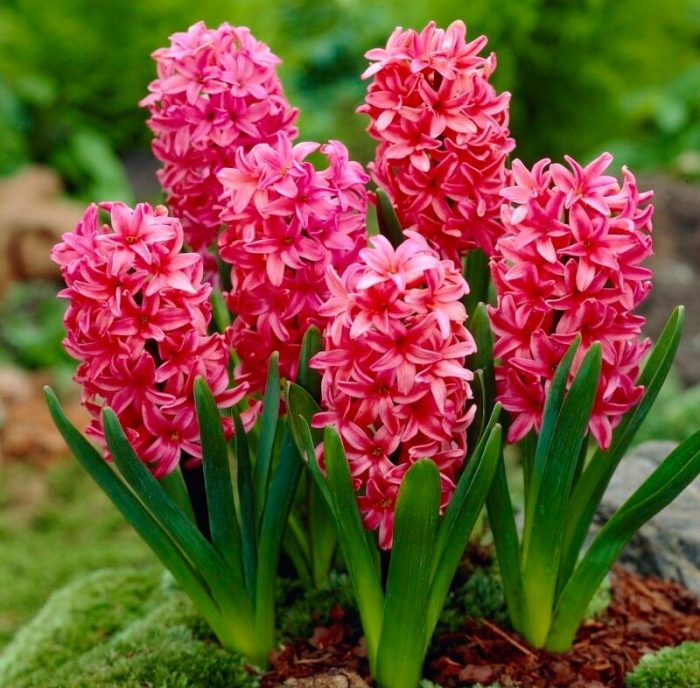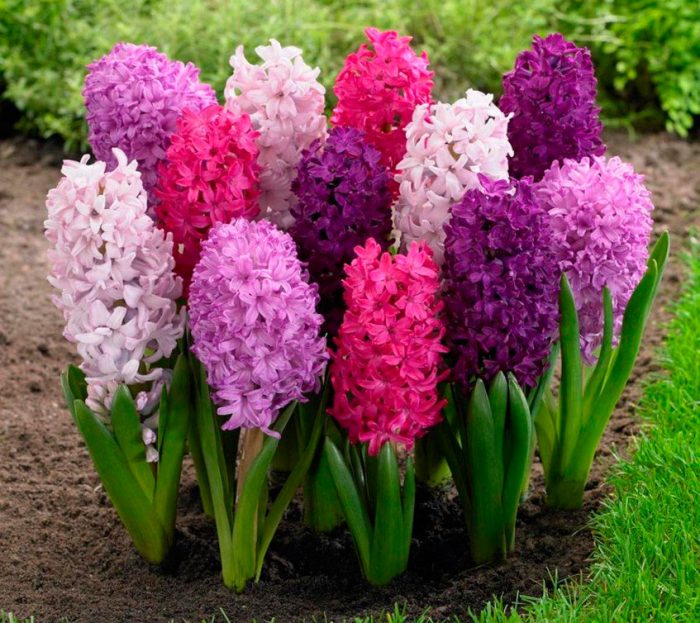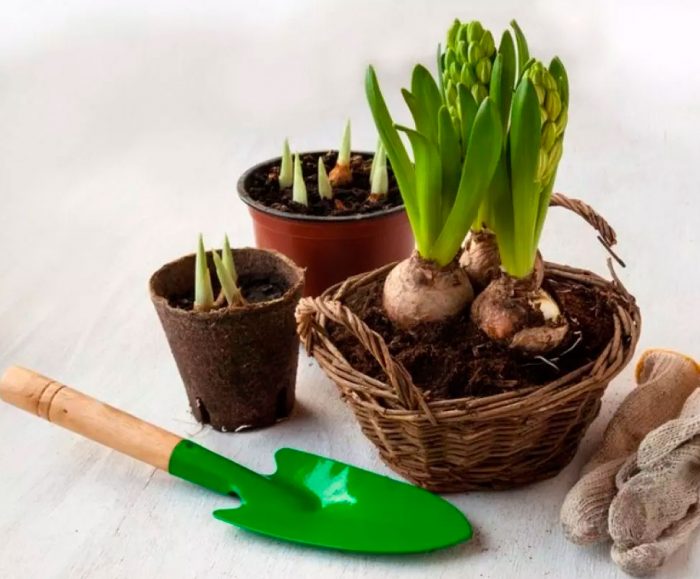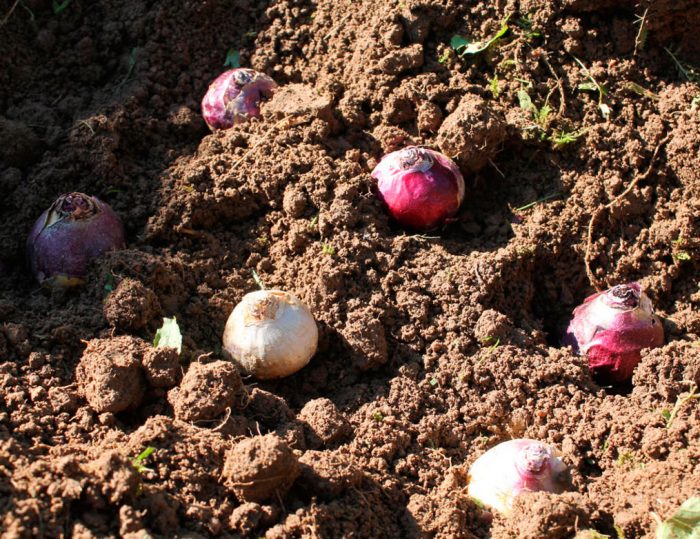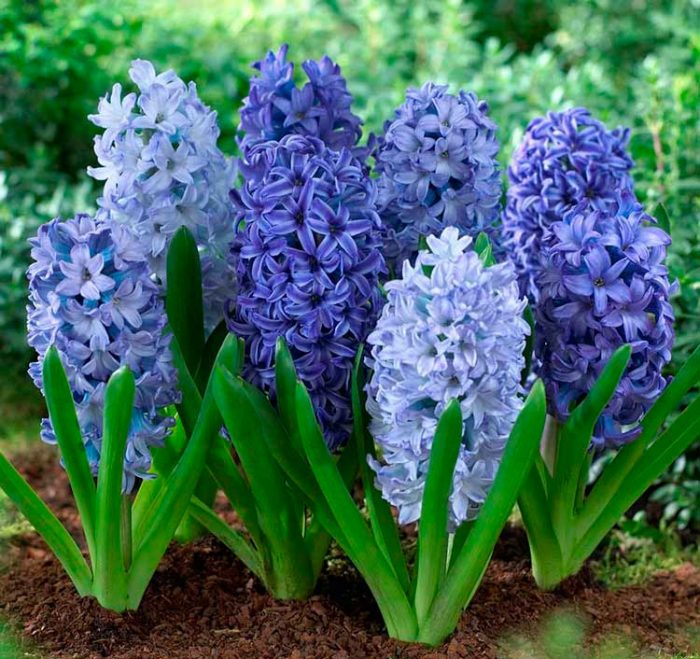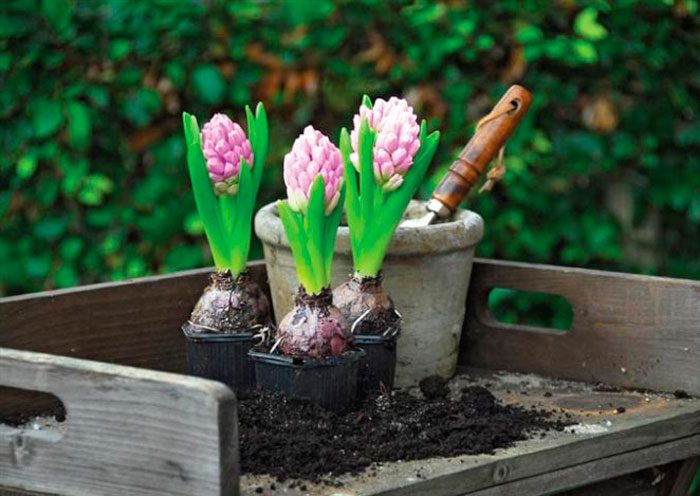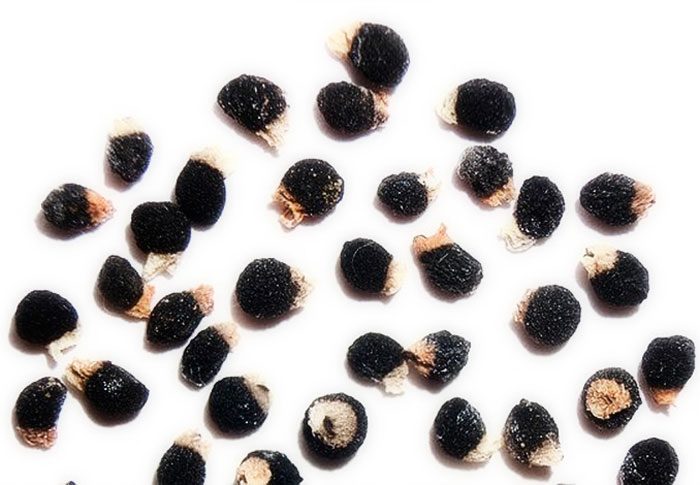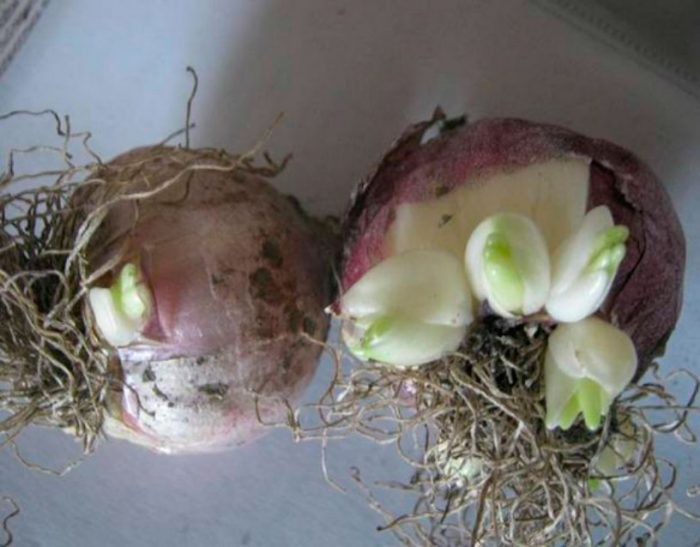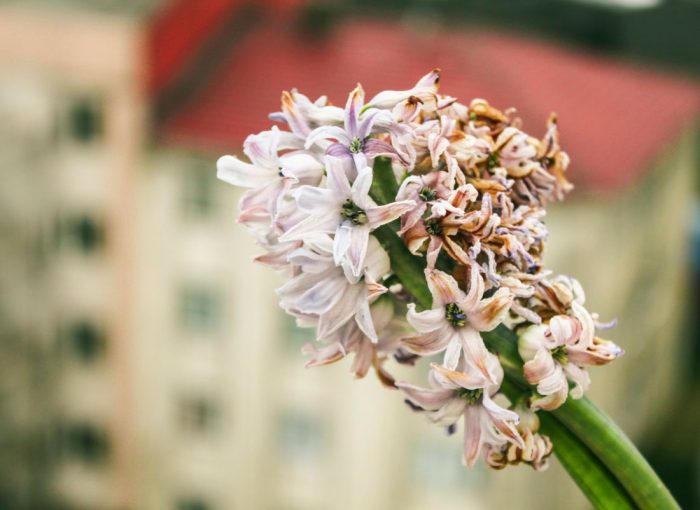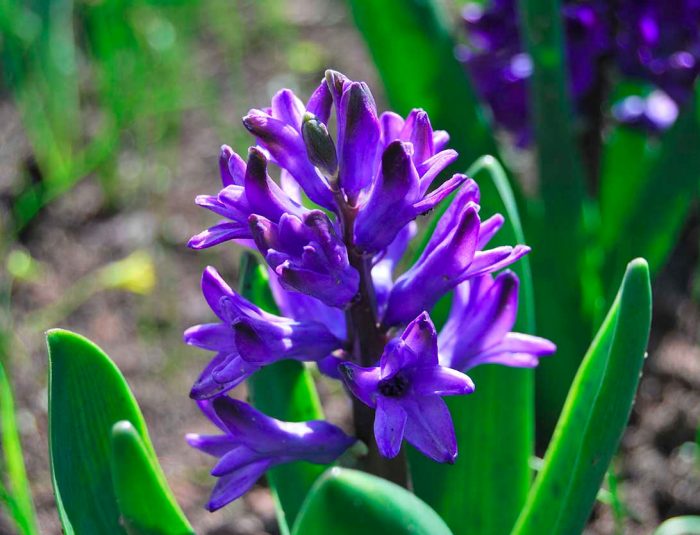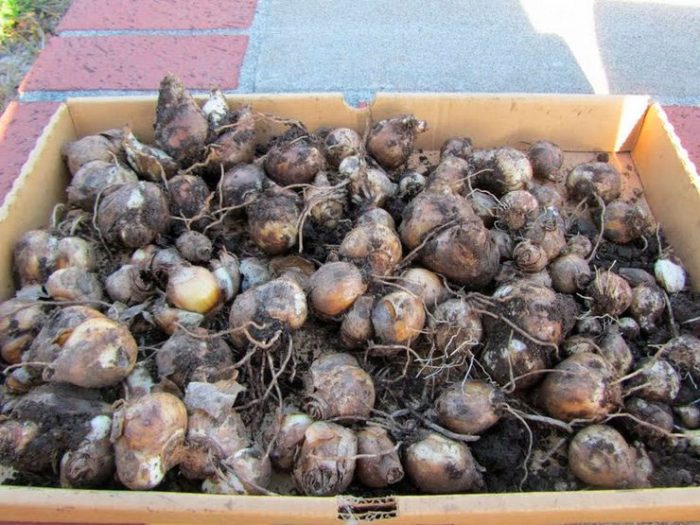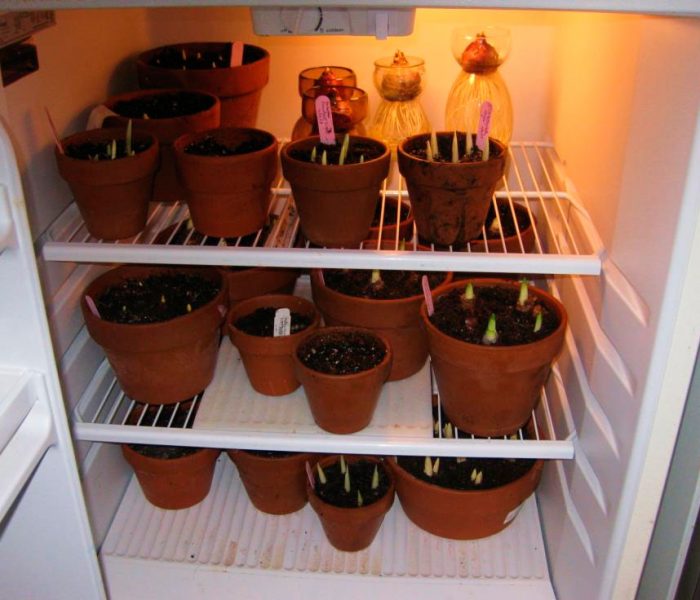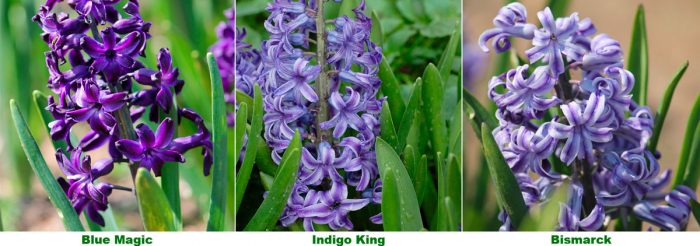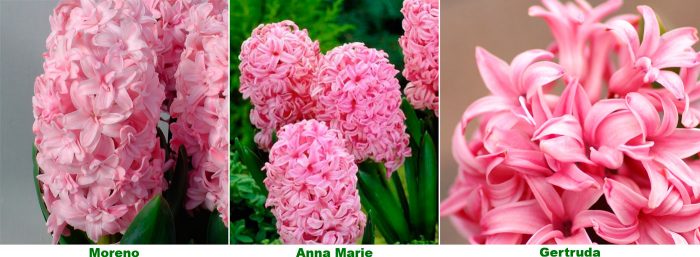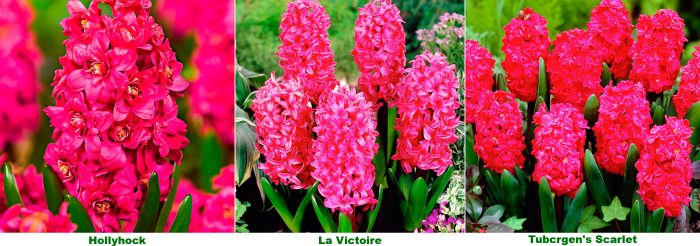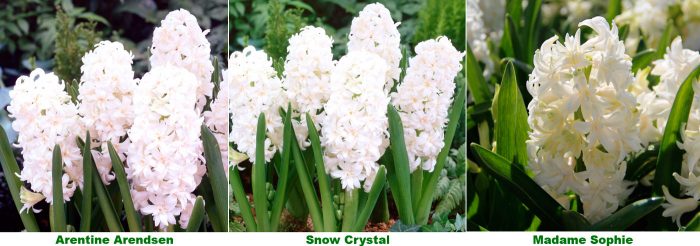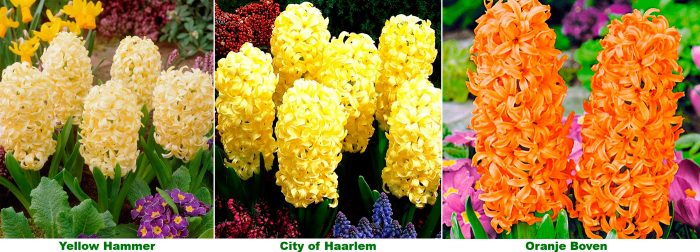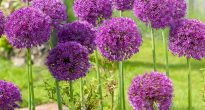The bulbous flowering perennial plant hyacinth (Hyacinthus) is a member of the Asparagus family, but it used to be part of the Liliaceae family, and it was also isolated as a separate Hyacinth family. Translated from the ancient Greek, hyacinth means "rain flower". The plant was named in honor of the hero of the ancient Greek myth. There lived in those ancient times a very handsome young man Hyacinth, the son of the king of Sparta. His friend was the god Apollo, he often descended from heaven to earth to teach Hyacinth to throw discs. And then somehow, while training Hyacinth, Apollo threw a disc, and the young man rushed after him to return it to God. However, the god of the West Wind, who was secretly in love with the prince, being jealous of him, was able to turn the disk in such a way that he broke the handsome man's head. Hyacinth was dying in his friend's arms, and he could do nothing to save him. Then the god, heartbroken, decided to create an incredibly beautiful flower from the drops of blood of a beautiful young man, which was named hyacinth.
Content
Brief description of cultivation
- Landing... Planting hyacinth bulbs is carried out in autumn in September or October. And they dig them out every year after the foliage turns yellow (in the last days of June or early July).
- Storage... For storage, the bulbs are removed in a well-ventilated area with moderate humidity. They are placed in paper bags or in 2 layers in boxes. For the first two months, planting material is stored at a temperature of about 25 degrees, and then it is transferred to a cooler place (about 17 degrees).
- Illumination... Needs lots of bright sunlight.
- Priming... It must be nutritious, water permeable and contain a lot of humus. The acidity should not be less than 6.5.
- Watering... During a prolonged drought, water the hyacinths in such a way that the soil is soaked to a depth of 15 to 20 centimeters.
- Fertilizer... You need to feed the flower twice or three times throughout the season. The first top dressing - at the very beginning of the growing season with phosphorus-nitrogen fertilizer, the second - during the formation of buds and the third - when the bush fades with phosphorus-potassium fertilizer.
- Reproduction... Seeds and children.
- Harmful insects... Flower flies (hoverflies), aphids, thrips, onion root mites, stem and root nematodes and bears.
- Diseases... Penicillus rot, rhizoctonia, fusarium, yellow or soft bacterial rot, variegated stems.
- Properties... Any part of the plant contains a poisonous alkaloid.
Features of hyacinth
Hyacinth is one of the earliest spring flowers. This plant is native to North Africa, the Middle East and the Mediterranean. However, Holland has done a lot to popularize hyacinth, which is why many people call it the world "hyacinth center". The largest number of varieties and varieties of hyacinth appeared in the Netherlands. And from the city of Haarlem, which is located in Holland, a huge number of bulbs of this flower are sent around the world every year.
In hyacinths, a dense bulb consists of lower juicy leaf plates. The height of the flowering stem is about 0.3 meters, it is a continuation of the bottom. In a faded bush, the stem dries up along with narrow leaf plates directed upward, which sit at the very bottom of the stem. However, in the corner of the upper leaf plate on the stem inside the bulb, a bud is formed, which eventually becomes a new bulb, it is she who will bloom next year. Bulbs can also form in the corners of other leaf plates, but they are weaker. These bulbs are babies, if necessary, they can be separated and new bushes grown from them. Flowers are part of the apical brushes, which have a conical or cylindrical shape. In a flower, the perianth has the shape of a bell-shaped funnel, its blades are bent, and the color is saturated. The inflorescences can be painted in different color shades, for example: red, purple, yellowish, white, pink, blue, etc. Flowers can be double and simple. In such a plant, the fruit is three-nested, while in each of the nests there are a pair of seeds covered with a delicate peel.
Growing features
Each crop has its own agronomic requirements. Hyacinth differs from many flowers in that it is quite capricious and demanding to care for. That is why, before decorating your garden with it, you need to learn how to properly care for it, and what it needs for normal growth and development. Basic rules for growing hyacinth:
- The soil must be neutral, it must include sod and leafy soil (1: 1), as well as a baking powder. If the soil is acidic, then lime will have to be added to it, and clay soil can be corrected by adding sand to it.
- This plant reacts extremely negatively to stagnant water in the soil, which is why it should be provided with good drainage.
- For growing hyacinths, choose a sunny place, but excessively bright lighting can harm it.
- An area that is close to trees and shrubs is well suited for planting, because the flowers must be protected from gusts of wind.
- Do not feed hyacinths with fresh organic fertilizer.
Planting hyacinths in open ground
What time to plant
Hyacinth bulbs are planted in open soil in the last days of September or the first in October. If you plant them ahead of time, then they can start growing, and the coming winter cold will destroy them. If they are planted later than necessary, then they may not have time to take root well before frost.
The area where hyacinths will grow must be prepared in advance. Dig the soil to a depth of 0.3 to 0.4 m, while injecting 10 to 15 kilograms of rotten compost or three to four year old humus into the soil, as well as about 15 grams of magnesium sulfate, 70 grams of superphosphate and 30 grams of potassium sulfate from calculation for 1 square meter. Depending on what the soil consists of, peat or sand can be added to it, if necessary.If the soil on the site is sandy, then 1.5 times more potash and magnesium fertilizers should be added to it. It is recommended to feed hyacinths with nitrogen-containing fertilizers in the spring-summer period.
Planting in autumn
It has already been said above that hyacinth bulbs are planted in the garden in autumn, or rather, in September-October. Experienced gardeners advise planting medium-sized bulbs, which are also called "flower beds", because they give flower stalks that are highly resistant to bad weather.
First, inspect the planting material and remove any diseased, soft or injured bulbs. Then, before planting in the soil, they are immersed in a solution of a fungicidal preparation for 30 minutes. The bulbs, reaching about 50 mm in diameter, are planted to a depth of 15 to 18 centimeters from the bottom, the row spacing should be about 20 centimeters, and the distance between the bulbs should be 15 centimeters. Smaller bulbs, as well as children, are planted at a shallower depth, while the distance between them must also be reduced.
Hyacinth grows best in open soil when planted in a "sand jacket". To do this, a layer of pure river sand is poured onto the bottom of the groove or the landing pit, the thickness of which should be about 30–50 mm. Press the bulb a little into this layer and sprinkle it on top with sand and only then with soil. Thanks to this method of planting, there will be no stagnation of water in the ground, as a result of which the risk of rot on the bulb will be significantly reduced. If the bulbs were planted in dry soil, then they must be watered.
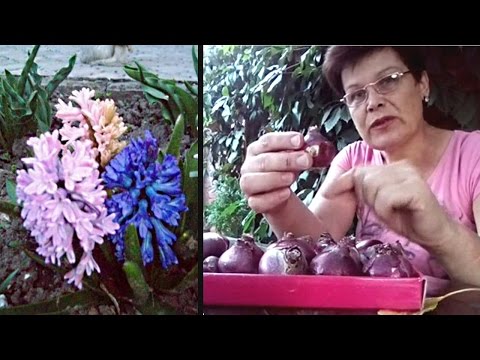

Watch this video on YouTube
Spring planting
Hyacinth bulbs are not planted in spring.
Hyacinth care
It is not too difficult to care for hyacinth grown in the open field, but you need to know all the agrotechnical rules of culture and be sure to follow them. First of all, you need to ensure that there are no weeds in the area on which the hyacinth grows, therefore weeding should be regular and timely. It should also be remembered that the surface of the soil around the bushes must be systematically loosened up and this is done quite often. In order to reduce the number of watering, weeding and loosening after planting the bulbs in the ground, its surface is covered with a layer of mulch. Watering the hyacinth is necessary only during a drought, while the soil must be soaked 15–20 centimeters deep.
Fertilizer
In order for such flowers to grow well and develop, they must be fed in a timely manner. During the growing season, you need to feed the bushes only 2 or 3 times. Flowers can be fed with dry fertilizer by adding it to the soil, or with liquid nutrient solution (in this case, slightly less fertilizer is used). Before adding a nutrient solution to the soil, the flowers must be watered. If dry fertilizers are used, then they are scattered over the surface of the site, and then embedded in the ground using a hoe. Time of feeding:
- the first - at the very beginning of the growing season, for feeding use from 20 to 25 grams of nitrate and 15–20 grams of superphosphate per 1 square meter;
- the second - during the formation of buds, for this, 30 to 35 grams of superphosphate and 15–20 grams of potassium sulfate are added to the soil per 1 square meter;
- the third - after the bushes have faded, for this use 30-35 grams of potassium sulfate and the same amount of superphosphates per 1 square meter.
Transfer
In order to transplant hyacinths to another site, it does not take much effort. To begin with, in the summer, when the bushes have faded, dig up the bulbs and store them. And with the onset of autumn, plant them on a new site. The bulbs are dug out a couple of months after the hyacinths have faded.This time is necessary so that the bulbs have time to recover after the growing season and flowering.
Reproduction of hyacinths
Growing from seeds
Hyacinth can be propagated by seed, which is ideal for those who are engaged in plant breeding. Sowing seeds is carried out in the last days of September, for this they use a box filled with a substrate consisting of humus, leafy soil and sand (2: 1: 1). Seedlings are grown for two years in a cold greenhouse. Hyacinths that have emerged from seeds very rarely retain the varietal characteristics of the parent plant, which is why gardeners prefer to propagate such a plant in a vegetative way.
Reproduction by children
It is much easier to propagate hyacinth with children than with seeds. But at the same time, it must be taken into account that babies on bulbs grow extremely slowly, so, in 1 year, from 1 to 3 babies can form. Try to separate the kids from the parent bulb, if they come off without much effort, then they are planted in a separate hole and grown. However, if the children are separated with great difficulty, then they are left on the parent bulb, which is planted in the ground with them.
In industrial floriculture, hyacinths are propagated by artificial methods, namely by incising and cutting out the bottom. To do this, take a very sharp instrument and sterilize it well, make cuts on the bottom with it, or cut it out altogether. Further, the bulbs are removed for storage in a special way, and children are formed in them. It happens that about 40 babies are formed on one bulb. This method of reproduction of hyacinths is described in great detail in the book "Reproduction of Plants" by F. McMillan Brose.
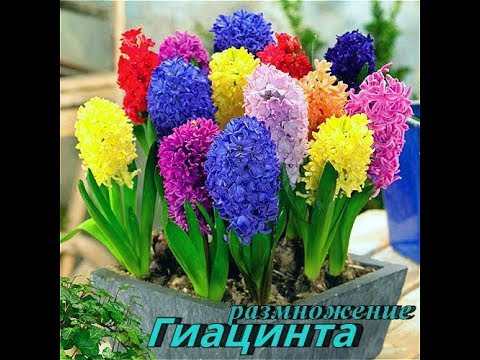

Watch this video on YouTube
Diseases and pests of hyacinths
Diseases
Hyacinths are quite resistant to disease. However, if they were affected by the disease, then this could happen for the following reasons:
- the purchased planting material was already affected by the disease;
- the flowers were fed with fresh organic fertilizer;
- bad predecessors;
- a spoiled onion was planted in the ground;
- before planting, the bulbs were not subjected to preventive treatment;
- too dense planting.
Most often, this plant is affected by bacterial rot (bacterial disease), because of it the bulbs become like mucus, which smells very bad. The first signs of rotting - the bush lags behind in growth, and stripes and spots form on its foliage and peduncles. Sick flowers are removed from the soil and destroyed, and the place where they grew is treated with bleach.
Another hyacinth can be struck by penicillous rot (fungal disease). All parts of the affected bush that are above the ground are covered with plaque, which is a product of sporulation of the fungus, rot appears on the plant, and its flowers dry out. To save the plant, it must be treated with a copper-containing product.
Harmful insects
Various pests can also greatly harm the hyacinth. The greatest danger to him is represented by flower flies, their larvae gnaw the bottom of the bulbs. In order to get rid of them, they use such means as: Tabazol, Mukhoed or Aktara. Also, a bear can harm the flower, which eats its underground part, as well as a root onion mite; it is best to fight such pests by mulching the soil surface around the bushes.
It happens that the inflorescence just appears from the outlet and almost immediately falls out of it. This can happen due to stagnation of water in the ground, due to storage of bulbs in a very cold place, or due to early planting.
Post-flowering care
After the hyacinths have faded, their bulbs begin to regain their strength. Therefore, they must definitely stay in the soil for some time. As soon as the bushes begin to fade, all care should be reduced to a gradual reduction in watering, until they are completely stopped.In addition, do not forget to fertilize the soil at this time for the third and last time, thanks to it, the bulbs will receive the necessary amount of nutrients, which will have a beneficial effect on the growth and flowering of hyacinths in the next season. You can understand that the time has come to remove the bulbs from the ground by the foliage, which should turn yellow.
Digging out the bulbs
It is necessary to remove the bulbs from the soil every year. Otherwise, in the next season, the bushes will bloom sparsely, and the likelihood that the bulbs will be affected by the disease increases. Also, thanks to the digging of hyacinths, which is carried out every year, it is possible to discard spoiled bulbs in a timely manner and regularly separate the children.
Try to dig up the bushes before their foliage dies and falls off, as in this case it is very difficult to find the exact location of the bulbs. A shovel is used to extract the bushes from the ground, since the bulbs are quite deep. The removed bulbs will need to be rinsed under running water and etched for half an hour in a solution of Karbofos (3-4%); instead, they can be used for 10 minutes. soak in very warm water (about 50 degrees). After that, they are placed in a shaded, well-ventilated place to dry for 7 days, the air temperature should be about 20 degrees.
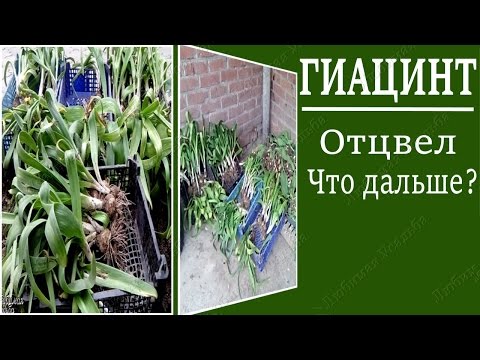

Watch this video on YouTube
Storage of hyacinth bulbs
At this time, the care of the bulbs must be taken with full responsibility, since right now the inflorescence will be forming in them. After the bulbs are dried, they need to remove the remnants of scales and roots. Then they are sorted and laid out in boxes (preferably in 1 layer). Babies that are too small are best left on the bulbs. If there are few bulbs, then paper bags can be used to store them, on which a signed label is glued.
During storage of hyacinths, 2 stages are distinguished. During the first two months, the bulbs should be at a temperature of 25 to 26 degrees, and then they are removed to a cooler place (about 17 degrees). The air should not be too dry, as this can dry out the bulbs. In order to shorten the first stage of storage by 7 days, the planting material must be stored at a temperature of about 30 degrees during the first week. Remember to keep hyacinths in a well-ventilated area. And immediately before planting the bulbs in the fall in the ground, it is recommended to keep them for about 7 days at the temperature that is typical for the garden. As a rule, during storage, a large number of small children are formed on the bulbs, in this regard, they need to be planted very carefully in the soil.
Types and varieties of hyacinths with photos and names
Hyacinth has been cultivated both outdoors and indoors for about 400 years. And not so long ago, experts believed that there are about 30 species and about 500 varieties of hyacinths. However, when there was a reorganization of classifications in botany, most of the species were transferred to another genus. Today, there are only 3 types of hyacinths, namely: oriental hyacinth (Hyacinthus orientalis), Litvinov's hyacinth (Hyacinthus litwinowii) and Transcaspian hyacinth (Hyacinthus transcaspicus). Thanks to the efforts of breeders, many varieties and varieties have been obtained from these species.
All varieties are divided according to the shape of the flower - into double and simple, according to the flowering time - late, early and medium, as well as according to the color of the flowers. In the classification by flower color, all varieties are divided into 6 groups.
Blue hyacinths
- Perle brillante... This is a late-flowering variety, the flowers of which are pale blue, the height of the bush is about 25 centimeters, the duration of flowering is about 20 days.
- Marie... An early flowering variety that lasts 16 to 18 days. The flowers have a dark blue color and are decorated with a longitudinal purple stripe.
- Queen of the blues... Flowering of this medium variety lasts about 15 days, the height of the bush is about 30 centimeters.Bluish flowers have a faint smell.
Lilac hyacinths
- Blue magic... The height of the bush in this medium variety is about 25 centimeters, flowering lasts from 10 to 12 days. The color of the flowers is purple-purple.
- Indigo king... This late-flowering variety blooms for about 15 days, the arrow length is 15 to 17 centimeters. The flowers are glossy purple-black.
- Bismarck... The flowering of this early flowering variety lasts about half a month, the bush reaches a height of 22 to 25 centimeters. Light purple flowers are decorated with a longitudinal strip of a more saturated shade.
Pink hyacinths
- Moreno... An early flowering variety blooms for 13-18 days, the peduncle reaches 20 to 23 centimeters in length. The color of the flowers is raspberry pink, they have a strip of a darker shade.
- Anna marie... This medium variety has a long arrow - from 20 to 25 centimeters, and its flowering lasts about 15-17 days. The flowers are painted in a pale pink shade.
- Gertruda... Flowering of this late-flowering variety lasts from 13 to 15 days, and its peduncle reaches 23-25 centimeters in height. The flowers are dark pink.
Red hyacinths
- Hollyhock... This late-flowering variety blooms for 15-18 days, its peduncle has a height of 20-22 centimeters. Double flowers have a crimson-red color.
- La Victoire... The height of the peduncle in this early flowering variety is from 20 to 25 centimeters, glossy pinkish-red flowers open on it. Duration of flowering is from 11 to 12 days.
- Tubcrgen's Scarlet... The flowering of such an average variety lasts a little longer than half a month. The height of the peduncle is about 20-22 centimeters, the flowers are deep red, can be double.
White hyacinths
- Arentine arendsen... The height of the bush of this early flowering variety reaches 21-22 centimeters, it blooms from 15 to 18 days. The flowers are white, they can have a cream shade.
- Snow crystal... This late blooming hyacinth has white double flowers. The flowering period is 13–18 days, and the stem length is 25–28 centimeters.
- Madame sophie... Flowering of such a medium variety lasts 13-15 days, the length of its stem is from 19 to 23 centimeters. Double flowers are white in color.
Yellow and orange hyacinths
- Yellow hammer... The arrow of such an average variety reaches 23-25 centimeters in length, it blooms from 13 to 15 days. Flowers painted in a deep yellow color fade by the end of flowering.
- City of haarlem... The late flowering variety has a flowering duration of 15 to 17 days, the length of the peduncle is from 25 to 27 centimeters. The yellowish flowers turn pale cream at the end of flowering.
- Oranje boven... The flowering of such a medium variety lasts about half a month. On peduncles 22-24 centimeters long, apricot-salmon flowers flaunt, the edge of which is dark pink.
Most often, blue varieties begin to bloom first, and then white, pink, red, lilac. And orange and yellow varieties bloom later than everyone else.
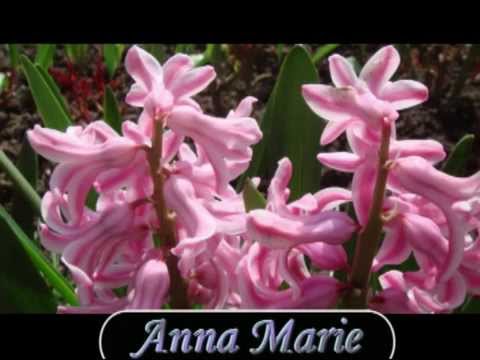

Watch this video on YouTube

